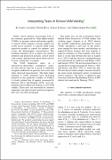| dc.contributor.author | Walters, Christopher | |
| dc.contributor.author | Angrist, Joshua | |
| dc.contributor.author | Hull, Peter Davenport | |
| dc.contributor.author | Pathak, Parag | |
| dc.date.accessioned | 2016-10-24T19:05:33Z | |
| dc.date.available | 2016-10-24T19:05:33Z | |
| dc.date.issued | 2016-05 | |
| dc.identifier.issn | 0002-8282 | |
| dc.identifier.issn | 1944-7981 | |
| dc.identifier.uri | http://hdl.handle.net/1721.1/104953 | |
| dc.description.abstract | We develop over-identification tests that use admissions lotteries to assess the predictive value of regression-based value-added models (VAMs). These tests have degrees of freedom equal to the number of quasi-experiments available to estimate school effects. By contrast, previously implemented VAM validation strategies look at a single restriction only, sometimes said to measure forecast bias. Tests of forecast bias may be misleading when the test statistic is constructed from many lotteries or quasi-experiments, some of which have weak first stage effects on school attendance. The theory developed here is applied to data from the Charlotte-Mecklenberg School district analyzed by Deming (2014). | en_US |
| dc.description.sponsorship | National Science Foundation (U.S.) | en_US |
| dc.description.sponsorship | Laura and John Arnold Foundation | en_US |
| dc.description.sponsorship | Spencer Foundation | en_US |
| dc.language.iso | en_US | |
| dc.publisher | American Economic Association (AEA) | en_US |
| dc.relation.isversionof | http://dx.doi.org/10.1257/aer.p20161080 | en_US |
| dc.rights | Article is made available in accordance with the publisher's policy and may be subject to US copyright law. Please refer to the publisher's site for terms of use. | en_US |
| dc.source | American Economic Association | en_US |
| dc.title | Interpreting Tests of School VAM Validity | en_US |
| dc.type | Article | en_US |
| dc.identifier.citation | Angrist, Joshua, Peter Hull, Parag Pathak, and Christopher Walters. “Interpreting Tests of School VAM Validity.” American Economic Review 106, no. 5 (May 2016): 388–392. ©2016 American Economic Association. | en_US |
| dc.contributor.department | Massachusetts Institute of Technology. Department of Economics | en_US |
| dc.contributor.mitauthor | Angrist, Joshua | |
| dc.contributor.mitauthor | Hull, Peter Davenport | |
| dc.contributor.mitauthor | Pathak, Parag | |
| dc.relation.journal | American Economic Review | en_US |
| dc.eprint.version | Final published version | en_US |
| dc.type.uri | http://purl.org/eprint/type/JournalArticle | en_US |
| eprint.status | http://purl.org/eprint/status/PeerReviewed | en_US |
| dspace.orderedauthors | Angrist, Joshua; Hull, Peter; Pathak, Parag; Walters, Christopher | en_US |
| dspace.embargo.terms | N | en_US |
| dc.identifier.orcid | https://orcid.org/0000-0001-6992-8956 | |
| dc.identifier.orcid | https://orcid.org/0000-0003-3910-1573 | |
| dc.identifier.orcid | https://orcid.org/0000-0001-8621-3864 | |
| mit.license | PUBLISHER_POLICY | en_US |
